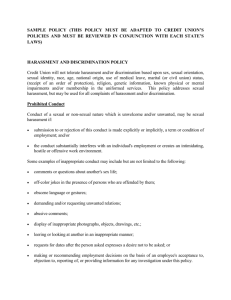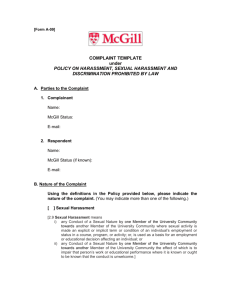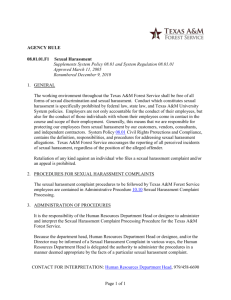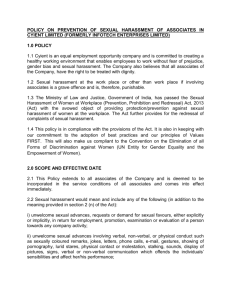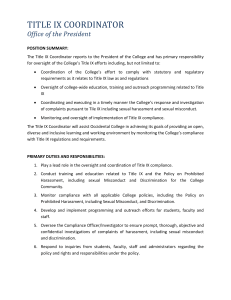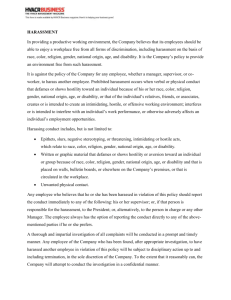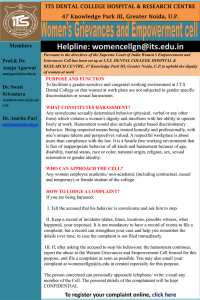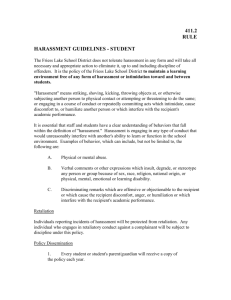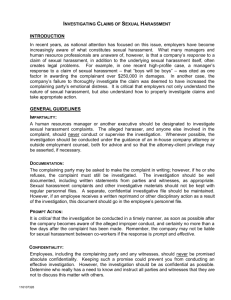anti-harassment - ExteNet Systems
advertisement
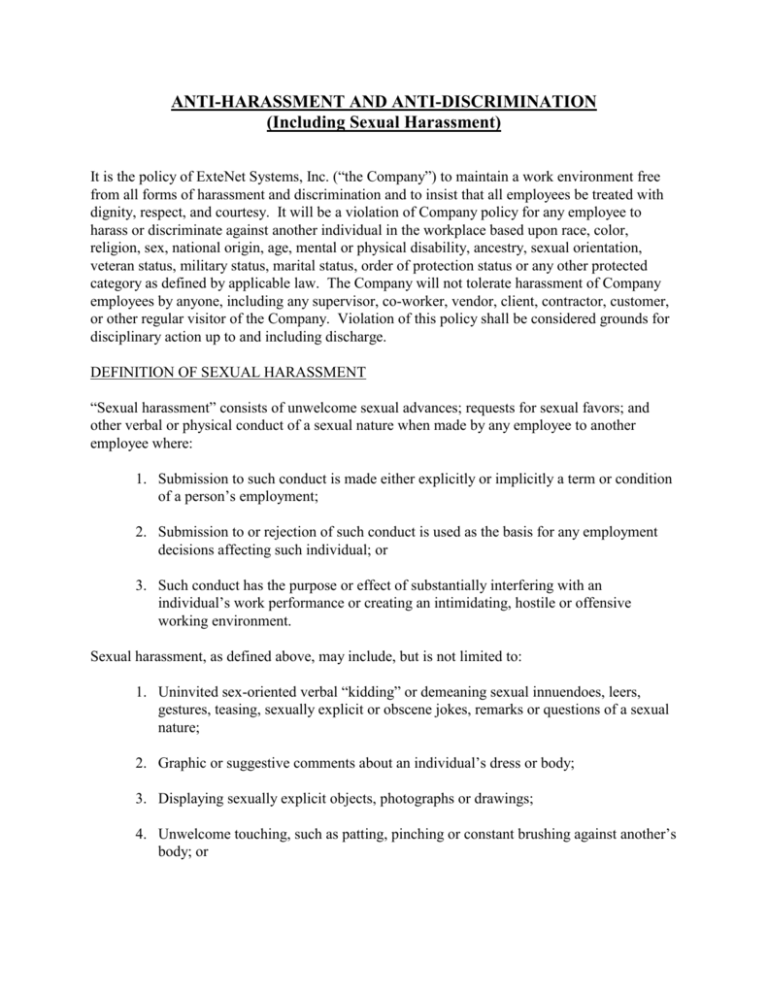
ANTI-HARASSMENT AND ANTI-DISCRIMINATION (Including Sexual Harassment) It is the policy of ExteNet Systems, Inc. (“the Company”) to maintain a work environment free from all forms of harassment and discrimination and to insist that all employees be treated with dignity, respect, and courtesy. It will be a violation of Company policy for any employee to harass or discriminate against another individual in the workplace based upon race, color, religion, sex, national origin, age, mental or physical disability, ancestry, sexual orientation, veteran status, military status, marital status, order of protection status or any other protected category as defined by applicable law. The Company will not tolerate harassment of Company employees by anyone, including any supervisor, co-worker, vendor, client, contractor, customer, or other regular visitor of the Company. Violation of this policy shall be considered grounds for disciplinary action up to and including discharge. DEFINITION OF SEXUAL HARASSMENT “Sexual harassment” consists of unwelcome sexual advances; requests for sexual favors; and other verbal or physical conduct of a sexual nature when made by any employee to another employee where: 1. Submission to such conduct is made either explicitly or implicitly a term or condition of a person’s employment; 2. Submission to or rejection of such conduct is used as the basis for any employment decisions affecting such individual; or 3. Such conduct has the purpose or effect of substantially interfering with an individual’s work performance or creating an intimidating, hostile or offensive working environment. Sexual harassment, as defined above, may include, but is not limited to: 1. Uninvited sex-oriented verbal “kidding” or demeaning sexual innuendoes, leers, gestures, teasing, sexually explicit or obscene jokes, remarks or questions of a sexual nature; 2. Graphic or suggestive comments about an individual’s dress or body; 3. Displaying sexually explicit objects, photographs or drawings; 4. Unwelcome touching, such as patting, pinching or constant brushing against another’s body; or 5. Suggesting or demanding sexual involvement of another employee whether or not such suggestion or demand is accompanied by implicit or explicit threats concerning one’s employment status or similar personal concerns. DEFINITION OF OTHER HARASSMENT Inappropriate conduct in the workplace, based upon an individual’s race, color, religion, sex, national origin, age, mental or physical disability, ancestry, sexual orientation, Vietnam-era veteran status, military status, marital status, order of protection status or any other protected category as defined by applicable law that has the purpose or effect of interfering with an individual’s work performance or creating an intimidating, hostile or offensive work environment. The conduct forbidden by this policy specifically includes, but is not limited to: (a) epithets, slurs, negative, stereotyping, or intimidating acts that are based on a person’s protected status; and (b) written or graphic material circulated within or posted within the workplace that shows hostility toward a person or persons because of their protected status. INVESTIGATION PROCEDURE All Company employees are responsible to help assure that we avoid harassment. Any individual who believes that he or she has been subjected to harassment or discrimination as prohibited by this policy or who has witnessed harassment or discrimination should submit a complaint to the Human Resources Director, or her designee, or any other manager or supervisor, in accordance with the following complaint procedures. If a manager or supervisor receives a complaint of harassment or discrimination directly from an employee, or becomes aware of such conduct, the complaint shall be immediately reported to the Human Resources Director, or her designee. 1. Any employee wishing to submit a complaint (i.e., the “complainant”) should submit a written statement to the Human Resources Director, or alternatively, the CFO, or his designee, in the event that they are the alleged harasser/discriminator. The written statement should state the specific facts and/or perceived wrongful act (e.g., location, names, dates, times) to be investigated. All such written statements should be submitted within thirty (30) days after the incident or act which gives rise to the complaint, unless the time for submission is extended by the Human Resources Director, or her designee, because the complainant has shown good cause for such an extension. 2. The Human Resources Director or her designee shall promptly investigate the complaint. The Human Resources Director or her designee shall make all reasonable efforts, including but not limited to convening a conference with the complainant, or the accused harasser/discriminator, to discuss the complaint and the results of the investigation, to resolve the matter informally. 3. If the complainant or the accused is not satisfied with the disposition of the investigation, he/she may submit in writing an appeal to the CFO or his designee, who will review the investigation report and make a final decision. At the CFO’s option, he or his designee may conduct further investigation, if necessary. 4. Reporting harassment, discrimination or retaliation or participating in an investigation will not reflect adversely upon an individual’s status or affect future employment. Any employee who retaliates against another for exercising their rights under this policy shall be subject to discipline up to and including discharge. 5. The rights to confidentiality, both of the complainant and of the accused, will be respected consistent with the Company’s legal obligations and with the necessity to investigate allegations of misconduct and to take corrective action when this conduct has occurred. 6. If an investigation results in a finding that the complainant falsely accused another of harassment or discrimination knowingly or in a malicious manner, the complainant will be subject to appropriate discipline, including the possibility of discharge. A substantiated charge against an employee will subject the employee to disciplinary action, up to and including discharge. The filing of a complaint under the procedures described herein shall not limit, extend, replace or delay the right of any person to file a similar complaint or charge with any appropriate local, State, or federal agency or court. DISSEMINATION The Company shall take reasonable measures to assure that employees are informed of this policy and procedure by inclusion in the Employee Handbook and by posting. A copy is also available in Human Resources.


